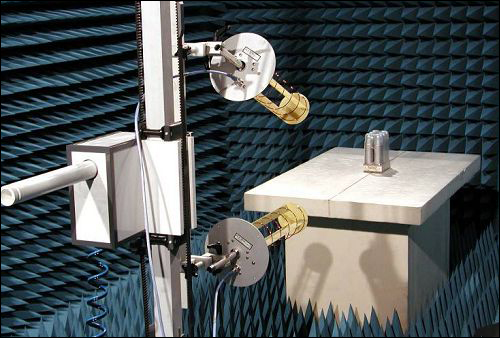An annual European study of passive ultrahigh-frequency (UHF) RFID tags (compliant with the EPC Gen 2 and ISO 18000-6C standards) has found that highly sensitive microchips have helped tags increase their read range by an average of 20 percent since last year. The new chips’ increased sensitivity, according to the study, means they require less power to respond to RFID readers. The European EPC Competence Center (ECCC) released its “2013-14 UHF Tag Performance Survey” (UTPS) this week, which finds an improvement in read distance by approximately 6 feet, compared with last year’s results. This, the survey’s authors predict, will allow a greater number of use cases for UHF RFID, since tags may be easier to read in challenging environments, such as at the center of a pallet, then they would previously have been.
Every year, scientists at the EECC conduct testing and publish the results related to the performance of UHF transponders for such use cases as supply chain tracking and item-level tracking on apparel or consumer goods packaging.
The 2013-14 study was partially funded by a program for regional competitiveness and employment, through NRW Bank, in North Rhine Westphalia (NRW), where the European EPC Competence Center is headquartered.
The EECC was founded in 2007 by Metro AG, GS1 Germany, Karstadt Warenhaus and Deutsche Post World Net, in order to help encourage the adoption of EPC RFID technology in Europe. Its reports—the first of which was published in 2007—are aimed at systems integrators, RFID solution providers, universities and research institutions, as well as some end users, and its plan is to develop reference materials indicating which type of tag is best suited for a particular application.
This year, the EECC tested 108 UHF labels, as well as 102 mount-on-metal (MOM) tags, at its laboratory in Neuss, Germany, according to Conrad von Bonin, the EECC’s CEO and the report’s co-author. This includes 46 new labels and 21 new MOM tags added since the 2012 survey. “The market grows steadily in all dimensions—companies, makes and models,” von Bonin explains. “We observe that there are now more special versions of existing designs and, especially, printable and flexible MOMs.” Altogether, the researchers conducted several thousand measurements at numerous UHF RFID frequencies, including the 865.6 to 867.6 MHz, 902 to 928 MHz, and 916.7 to 923.5 MHz bands used in Europe, North America and Japan, respectively. They used EECC proprietary reader equipment for the testing, since commercially available models provide variations in effectiveness when used with different types of tags.
The test consisted of three parts. During part one, tags were tested on four materials—each representing a specific product category—as well as in free air. In the second phase, tag behavior was tested with eight additional materials, and backlink (the backscatter transmission from a tag in response to interrogation by a reader) limitations were also tested. During the third phase, proximity effects were measured to determine how well tags are energized when packed close to each other, as well as the amount by which their close proximity reduced overall tag performance.
The group has increased its emphasis on the study of the proximity effect, which occurs in dense tag populations. That, explains Oliver Teschl, the project manager of Metro Group’s IT division, Metro Systems, and the 2013-14 UTPS report’s other co-author, is due to the growing number of applications for item-level tracking for such goods as apparel, CDs or DVDs, in which tagged merchandise is often packed into boxes stored within close proximity to each other.
In an effort to further address proximity read performance, the 2013-14 UTPS report includes a backlink matrix—a diagram indicating proximity effects for specific tags, based on those tags’ backscatter response to a reader. The EECC found that some recent microchips suffer from the same proximity effect problems that previous chips did. However, von Bonin says, the researchers are discovering that some tags manage this effect better than others, and that tag manufacturers are seeking to address the issue. According to von Bonin, the number of tags specifically designed for proximity reading has increased from one tag two years ago to seven in 2012 and 10 this year. “The four best ones on the market are new releases,” he states, such as Invengo‘s Scorpion, Trace-tech ID Solutions‘ TE14 Thinpropeller and Tagitron‘s PROtag series. “That is really great improvement,” he says.
This year, two new chips have entered the market: NXP Semiconductors‘ Ucode7 and EM Microelectronic EM4124 (see NXP Releases Ucode 7, a Faster and More Sensitive Chip and Avery Dennison’s New Tags Target Challenging Use Cases). These new chips have also affected the functionality of UHF tags, thereby increasing tag sensitivity.
A continuing shortcoming in tag read performance, identified on the survey, is that the sensitivity of tags has leapfrogged that of readers, since although the tags can be interrogated at a greater distance than previous versions, the readers themselves have not gained comparative receiving sensitivity (see European EPC Competence Center Report Finds New UHF Tags to Be More Sensitive). This problem was recognized last year, and the backlink matrix in the current report provides additional performance data regarding proximity scenarios, as well as for mount-on-metal tags. Some new high-resolution readers are able to meet the higher tag sensitivity, von Bonin notes, though the majority of readers currently on the market do not do so.
Of the on-metal tags tested, most used Alien Technology‘s Higgs chips. The group found a larger number of flexible on-metal tags, with as many as seven tested this year. Some of the tags require mounting on a metallic surface in order to operate properly, while others do not require a specific background. For that reason, the team measured them in the open air, as well as mounted on a metal plate.
A printed version of the 2013-14 study will soon be available for €995. Alternatively, individuals can buy a five-year subscription and pay €495 for the study.




